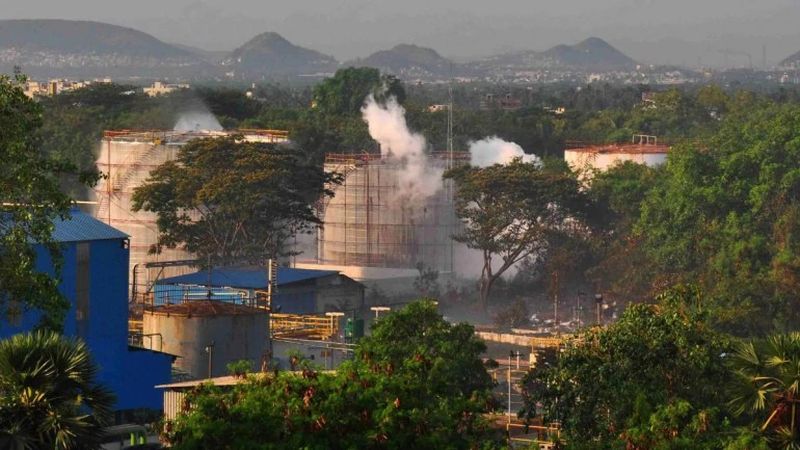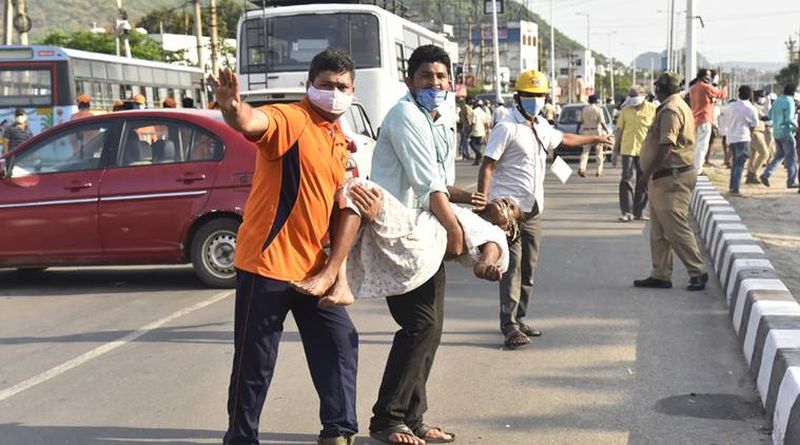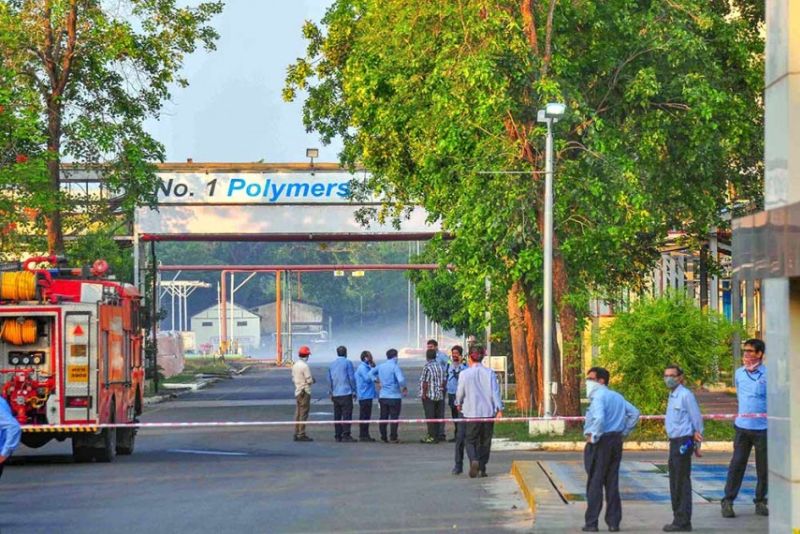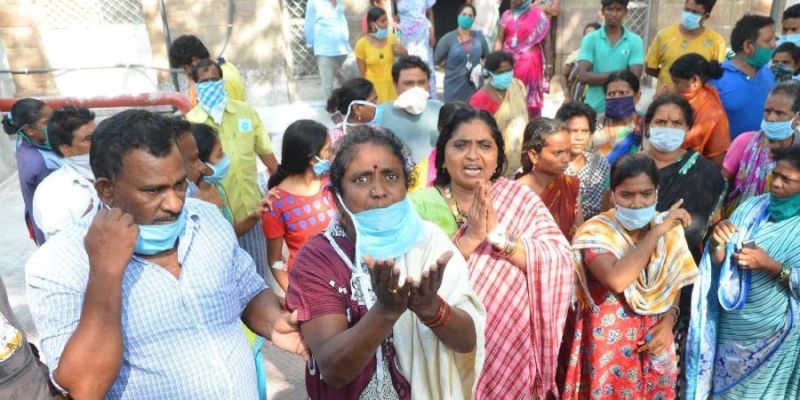Vizag Gas Leak: Disaster Reopens Bhopal Gas Tragedy Wounds
Vizag gas leak has reopened the wounds of another gas tragedy that still affects the people. The highly toxic substance made its way into and around the small towns located near the plant, where over 500,000 people were exposed to methyl isocyanate gas.
Our Prayers for the Speedy Recovery for those who are affected & Deepest Condolences to the Families who lost their lives. My SandArt with message .#PrayForVizag at Puri beach in Odisha #VizagGasLeak pic.twitter.com/8tf503gvCq
— Sudarsan Pattnaik (@sudarsansand) May 7, 2020
The disastrous chemical leak in a plant of LG Polymers India brought back the memories of Bhopal gas tragedy of 1984. The recent gas leak in Andhra Pradesh’s Visakhapatnam district resulted in hospitalisation of 200 people and 11 deaths. Over a thousand people were affected by the gas leak from the plant, which was left negligently amid the coronavirus lockdown.

Vizag gas leak in Visakhapatnam of Andhra Pradesh | Image: India Today
Vizag Gas Leak
The plant, operated by LG Polymers India Pvt Ltd, is a subsidiary of South Korea’s LG Chem Ltd. LG Chem said that gas leak from the plant has been stopped. LG Polymers claims it is one of the leading manufacturers of polystyrene and expandable polystyrene in India. The raw material, styrene, is highly flammable and releases poisonous gas when burnt.
According to the state government, eleven people including a child had died after the toxic gas leaked. At least 246 people with health complications are undergoing treatment at Visakhapatnam’s King George Hospital.

Eleven people have died in the recent Vizag gas leak | Image: The Indian Express
The local villagers informed the officials at around 3.30 AM on May 7, about the presence of gas in the air. As the news of gas leak spread, ambulances, fire engines and policemen rushed to the chemical plant. Thousands of the nearby villages were evacuated.
Andhra Pradesh chief minister YS Jagan Mohan Reddy announced an ex-gratia payment of ₹1 crore each to the kin of those killed in the styrene gas leak incident.
Very scary and tragic #VizagGasLeak
No Justice yet for Bhopal Gas Tragedy victims
This time “Absolute Liability” need to be fixed pic.twitter.com/NFegtXl0FT
— Kapil Mishra (@KapilMishra_IND) May 7, 2020
About 15 workers were filling styrene gas in the tank when the vapour leaked resulting in the major mishap. Sources say the stipulated 20 degrees temperature was not maintained during the lockdown period and subsequently while taking up the latest maintenance work.
Residents of habitations around Gopalapatnam, close to the site where the LG Polymers plant is located, passed out as the hazardous styrene vapour swept through the area at night.
Several deaths took place as people tried to flee, and the chemical rendered them unconscious. There are horrific stories of people falling from buildings, or into wells and ditches as they lost consciousness.
What’s Styrene and how it affects human health?
The gas leak triggered panic in the industrial coastal city. According to the preliminary reports, authorities said, the chemical that caused the deaths, and also illness in many others exposed to it, was styrene.
Styrene is a colourless, sweet-smelling liquid that serves as a raw material for plastics and polymers. It is widely used to make plastics and rubber. Consumer products including packaging materials, insulation for wiring and appliances, fibreglass, plastic pipes, automobile parts and drinking cups contain styrene.
Styrene is first compressed and turned into a liquid; then polymerisation takes place which turns it into a solid material.

Vizag gas leak happened at a gas plant at LG Polymers India | Image: Outlook India
Low levels of chronic exposure to styrene may be carcinogenic. According to the United States Environmental Protection Agency (EPA), short-term exposure to low levels of styrene in human can cause irritation in the mucous membrane and the eyes, and gastrointestinal effects.
Long-term exposure, on the other hand, results in effects on the central nervous system, leading to headaches, fatigue, weakness, hearing loss, nerve damage and depression.
According to the Health and Safety Executive, a UK government agency responsible for regulation and enforcement of workplace health, safety and welfare, the chemical can cause loss of consciousness and death at high exposure levels.
How it affects the lungs?
The Styrene gas, which leaked early on the morning of May 7, at the LG Polymers plant on the outskirts of Visakhapatnam, is highly carcinogenic and when inhaled, it has the effect similar to a “plastic coating” on the lungs.
According to Praveen Ramamurthy, professor at the Indian Institute of Science (IISC), Bengaluru,
Styrene is highly carcinogenic. It is highly flammable and hazardous. Normally, Styrene is used for making thermocol. It is not advisable to inhale it even in small quantities. When inhaled, the effect will be like a coat of plastic on the lungs. When oxygen supply cannot be sent to the brain, people will drop down.
When inhaled, swallowed or absorbed, Styrene affects the central nervous system and causes irritation to the skin, eyes and respiratory tract.
Long-term effects of Styrene
While short-term exposure to Styrene can cause irritation to the eyes, skin and nose, in long-term it could affect the central nervous system and kidney.
On term-term exposure, people can experience gastrointestinal and respiratory effects, headache, depression, fatigue, hearing loss and problem in concentrating.

Victims of LG Polymers gas leakage under treatment staged a protest at the Rajendra Prasad Ward and demanded for better treatment at KGH in Visakhapatnam | Image: EPS
The styrene gas that leaked from LG Polymers which has killed several people and created panic in several areas of Visakhapatnam leading to fleeing of homes in the vicinity of the plant is a poisonous, inflammable gas used in the plastic engineering industry, and could have triggered a series of explosions, according to experts.
Vizag Gas Leak – Latest Updates
May 11, 2020:
Days after the gas tragedy killed 11 people, about 13,000 tonnes of styrene from the LG Polymers plant at Visakhapatnam is being shipped back to the company’s headquarters in Seoul, South Korea. The Andhra Pradesh government authorities took up the issue with the Ministry of Shipping and arranged a special container to send the chemical back to Seoul.
Experts inspecting the aftermath of last week’s styrene gas leak have found, much to their shock, that there were other storage facilities at the factory that were vulnerable to a leak of vapour on a larger scale.
May 12, 2020:
The High-Power Committee (HPC) constituted to probe the cause behind the LG Polymers gas leak and suggest steps, which till now had elicited the opinion of various stakeholders, said it will have an interaction with the affected group in the next few days.


